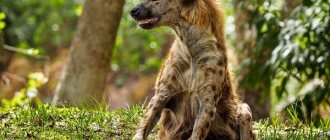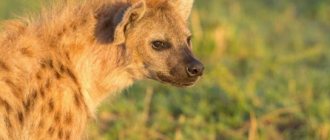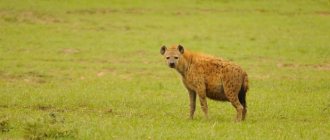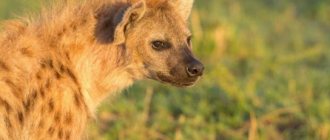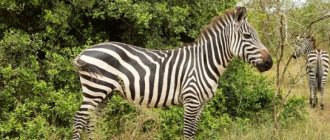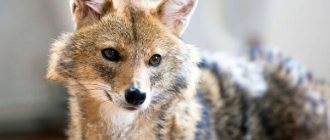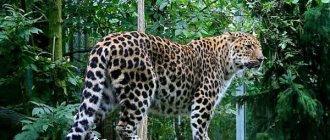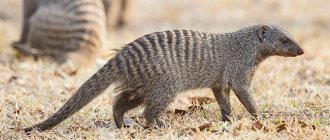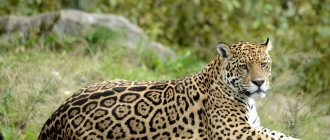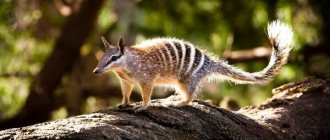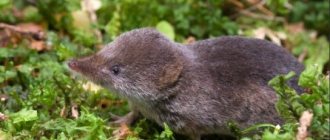In addition to deserts, Africa has numerous savannas. It is they who stretch across the entire continent, starting from the south of the Sahara and all the way to Kenya. An endless sea of grass, also called the savannah belt.
All vegetation in these regions is represented by shrubs and small thickets. The harsh subequatorial climate divides the whole year into 2 seasons - dry months of heat, and then long heavy rains.
In such conditions, wild animals are very dependent on the weather, since the conditions here are not the most comfortable.
Due to constant winds and a small amount of vegetation, these areas can only be inhabited by species that are able to adapt well.
One of these representatives are hyenas. They settle in flocks both in open spaces and on the edges of small forests. Quite often, they choose paths and roads as their habitat, where they might be able to profit from something.
Features and habitat of the hyena
Savannah belt is the name given to vast areas of African savannas covered with a carpet of grasses. This herbal kingdom stretches across the entire continent - from the south of the Sahara, then Niger, Mali, Sudan, Chad, also Tanzania and Kenya.
Savannas are comfortable for African animals; one of such interesting species is the wild hyena. Hyenas settle in open desert spaces, on the edges of forests near paths and roads. Vegetation in the savanna sometimes includes shrubs and rarely solitary trees.
The climate here is subequatorial. The year is divided into two seasons - dry and rainy. Africa looks interesting in pictures from space. From above you can clearly see the topography of this continent - most of it is occupied by deserts and evergreen rain forests. And in the center, a savannah stretches wide, full of free wind, grasses and rare lonely trees.
Scientists have established that the African savanna was formed about seven million years ago, this is proof that the savanna is a young zonal type. The life of plants and animals in savannas is directly dependent on the weather of these places.
Security status
All types of hyenas are quite rare animals, which is associated with a reduction in natural habitat and food supply caused by human activity. Nightlife and the inaccessibility of the places where hyenas live are the main reason why the lifestyle of these mammals remains poorly understood. Therefore, in many zoos around the world, spacious enclosures have been built, where conditions are recreated that are close to the natural habitat of predators. Here the animals feel at ease, as if in their natural habitat. Branched burrows or covered shelters are prepared for them so that mothers and their newborn babies feel safe.
Character and lifestyle of the hyena
For many, the hyena evokes negative emotions. Such people are sure that the hyena is an evil creature that feeds only on carrion and kills innocent victims. But the hyena is no meaner or more insidious than other wild predators.
Previously, the hyena was classified as a canine. But hyenas are closer to cats, mongooses or civets - a suborder of felines. Its lifestyle is similar to that of a dog, perhaps earlier, which is why hyenas were considered dogs.
One of the breeds is spotted, this hyena is an animal of Africa . Of its relatives hyenas - striped, brown, aardwolf, African hyena is the largest. In terms of size, the spotted hyena ranks third in the list of predatory animals in Africa.
The African fauna - lions, hyenas - is not limited only to these formidable predators. Hyenas' rivals are hyena dogs. Skirmishes often occur between these two clans - those with more individuals in their flock win.
Hyenas are amazing not only in their body physiology and way of life. The strange and scary sounds of the hyena animal frighten people even today. These unattractive-looking animals can produce rather peculiar vocal trills, moreover, accompanying various actions.
So, for example, a large and hearty dinner is announced with sounds reminiscent of evil human laughter. In the old days, people called this laughter demonic, and the hyena itself a servant of hell.
Such hyena voices sometimes do not always benefit this predator. For example, lions react strongly to the terrible laughter of hyenas, which is also very loud.
Listen to the hyena's laugh Listen to the hyena's voice
It serves as a signal to them that hyenas are nearby and have a lot of food. Sometimes lions take prey from hyenas, and the hyenas eat what they have. Savannah animals - hyenas - are always more comfortable in cool spaces. They mark their territory with feces or odorous secretions.
Pictured is a spotted hyena
So that none of the enemies or unfamiliar hyenas dare to invade the marked territory. The animals that own this place specially post someone from their pack for protection.
Hyena animals periodically move from one place to another in order to search for more food. Hyenas' lifestyle is usually nocturnal; during the day they rest after long marches or hunting.
The front legs of this wild hyena predator are longer than the hind legs, so it looks like a rather clumsy creature. But, this is a hardy animal, developing great speed and capable of running long distances. Spotted hyenas have endocrine glands on their paws, which produce a specific odor unique to each individual.
Pictured is a striped hyena
Hyenas are not, in fact, disgusting, unfeeling, or ugly. Eating carrion and excellent hunting, the hyena is not only a nurse, but also maintains balance among animals.
Laughing Hunter
During the hunt, hyenas maintain contact with members of their pack with special cries reminiscent of clucking and squealing - the so-called hyena laughter. Excellent eyesight and excellent hearing are faithful companions of animals. Hyenas can prey on absolutely any animal: from tiny rodents, birds and reptiles to antelopes, giraffes, hippos, buffalos or elephants; however, spotted hyenas hunt all these giants in packs. Hyenas are one of those predators that do not strangle their prey, but begin to tear it into pieces while it is still alive.
Hyena food
The main and most frequently consumed ungulates are hunted ungulates - wildebeest, zebras, gazelles, bison, and maybe buffalo. Sometimes, wild hyena animals can even feast on the cub of a larger animal.
Groups of animals are also included in the hyena's lunch diet, but more nutrients enter the body from caught prey. Be that as it may, it is not for nothing that the hyena is characterized by cowardice.
Hyenas are also impudent - there are times when one of the animal owners leaves the prey he has caught unattended for a while, and the hyena will try to steal it.
Such a single thief can be driven away even by a cheetah, who is fragile compared to a hyena, but when hyenas gather in a pack, it is almost impossible to cope with them alone.
Hyenas often attack sick and old animals, even lions. These cunning and not very brave predators also feed on small mammals, birds, reptiles, as well as their eggs.
And, of course, the remains of food from other carnivores. The amazing work of digestion is designed in such a way that wild animals hyenas can grind and digest bones, hooves, and wool.
Voice
The spotted hyena makes up to 11 different sounds. These animals use a prolonged howl, more like a “laugh,” to communicate with each other. During fights for prey, they “giggle”, “laugh”, growl and scream. Moans and squeals are used as greetings.
It is interesting that the flock reacts rarely or delayed to the sounds of males, but immediately to signals given by females. Low growls and grunting sounds (with the mouth closed) express aggression. A high-pitched "laugh", similar to a cackle, is produced when there is excitement or danger (for example, when a hyena is being chased). Predators use a loud and deep vibrating growl before an attack and during defense, as a threat. When a lion appears, a hyena signals its fellows with a loud, low growl.
Reproduction and lifespan
In order to engage in fertilization and subsequent conception of offspring, females are ready to mate every two weeks throughout the year. For males, everything depends on the seasons.
Hyena males must first fight among themselves for the female. And then, lowering your tail and head, obediently approach her and, if she allows you to do your job. Hyena pregnancy lasts 110 days.
Hyenas are born from one to three puppies. Mother hyenas give birth to cubs in burrows - their own or borrowed from one of the small animals, “refurbished” to their liking.
Often such a hole turns out to be a kind of “family home”, when several hyenas with newborn hyenas live in one hole. But hyena babies recognize their mother's voice, never making a mistake. Newborn hyena cubs are more developed than cubs of, for example, cats or dogs. Hyena babies are born with their eyes open and weigh about two kg.
But the mother hyena, despite the fact that her children are already quite well developed at birth, continues to feed them with milk for about another year and a half. Hyena cubs have no other food at this age other than mother's milk because... she does not regurgitate her food for them. And, at the same time, each mother feeds only her puppies. Small hyena cubs have brown fur.
Pictured is a baby hyena
As babies grow older, the color of their coat also changes. When the kids grow up, they will occupy the same status in the pack as their parents - by inheritance. The average lifespan of hyenas is 12 years. In general, hyenas are easy to train, and if they consider a person their friend, having gotten used to him and falling in love with him, they will always love their friend!
Hierarchy in packs
Wild hyenas live in matriarchal clans, on areas of up to 1800 square meters. km. There is a strict hierarchy in packs. Females occupy a dominant position over the opposite sex. However, there is an additional division between them. Adults are considered to be in charge. They are the first to start eating, rest at the entrance to the den, and raise more offspring. Females with a lower position in the pack do not receive such privileges, but belong to the middle of the hierarchy.
Males occupy the lowest level. At the same time, they also have a similar division. High-ranking individuals have priority access to females. But nevertheless, everyone demonstrates a general submissiveness to the other sex. To reproduce, males often join new flocks.
Among spotted hyenas, inter-clan wars for habitat constantly occur. The boundaries of the territory are constantly patrolled by these predators and are demarcated by feces, as well as anal secretions of odorous glands. The number of one clan can reach from 10 to 100 individuals.
Hunting
To catch prey, nature has endowed hyenas with short hind legs and long front legs, which allows them to develop enormous speed and cover fairly long distances without stopping.
As a hunter, the animal is much superior in skill to lions. They hunt mainly at night, covering more than seventy kilometers. When hunting, the mammal simply exhausts its prey by running long distances. At the same time, frightening her with a devilish laugh, turning into a howl. When the victim is unable to escape, they bite her legs, thereby completely immobilizing her. They eat their prey alive, and not, like other hunters, pre-suffocate it.
Their hearing, smell and vision are at the highest level. For example, they smell carrion at a distance of more than four kilometers.
Interesting Facts
- Since ancient times, humans have retained a prejudiced attitude towards the hyena. People's imagination has always been excited by the sloppy appearance and unpleasant smell emanating from this animal, its eating habits, behavior and, of course, the laughter of a hyena, similar to a human. All this gave rise to myths and various legends about this animal, which were passed down from generation to generation and gradually turned into facts. Only at the end of the 20th century (1984) a center for the study of the hyena family was opened in California at the University of Berkeley. There are still 40 spotted hyenas kept here today.
- The ancient Greeks believed that these animals are hermaphrodites, that is, a female can easily turn into a male and vice versa. Only after studying hyenas did modern scientists find out that among hyenas there are both females and males, but the external genitalia of males and females are very similar in appearance. The clitoris of female spotted hyenas is quite large and reaches a length of 15 cm, and the pouch-like fold formed by the labia resembles a scrotum in appearance. This unusual structure of the external genitalia of females is associated with increased levels of testosterone (male hormone) in the body of pregnant hyenas. The embryos developing in the womb seem to be “bathing” in this hormone. Subsequently, this also affects the character of the females.
- It is believed that hyenas are very cowardly, but, contrary to this belief, they are capable of taking prey from a lone lion or lioness. Sometimes old, sick lions themselves can become victims of hyenas.
- Representatives of the hyena family in the folklore of many nations have become the personification of betrayal, deceit, baseness, gluttony and greed. In the legends of the peoples of Africa, these animals are capable of not only laughing like a person, but also imitating his speech, inviting passers-by into the darkness, hypnotizing them with their gaze, and then killing them. Fortunately, there is no scientific evidence of hyena attacks on humans. But if the animal is driven into a trap, it can bite off the hunter's fingers.
- Most often, when in trouble, a hyena does not resist. Pretending to be dead, she waits for the danger to disappear, and then “comes to life.”
- In East Africa there are peoples who revere this animal. The Tavbs believe that hyenas are animals of the Sun that brought the light to the Earth to warm it. The Waniki people consider the hyena their ancestor and mourn its loss more than the loss of a chief.
Previously, people knew how to prepare healing potions from different parts of the hyena (skin, liver, brain, other organs), supposedly curing various ailments. For example, eye diseases were treated with her liver. The skin had “magical properties”; people believed that with its help they could protect crops in the fields and their homes from hail.
Video
Natural enemies
Spotted hyenas are at odds with lions. This is almost their only and constant enemy. Of the total deaths of spotted hyenas, 50% die from the fangs of a lion. Often it is a matter of protecting one's own borders, sharing food and water. This is how it happened in nature. Spotted hyenas will kill lions, and lions will kill spotted hyenas. During the dry season, drought or famine, lions and hyenas are always at war with each other over territory.
This is interesting! The fight between hyenas and lions is tough. It often happens that hyenas attack defenseless lion cubs or old individuals, for which they are attacked in return.
In the struggle for food and primacy, victory goes to the group of animals whose numbers predominate. Also, spotted hyenas, like any other animal, can be exterminated by humans.
